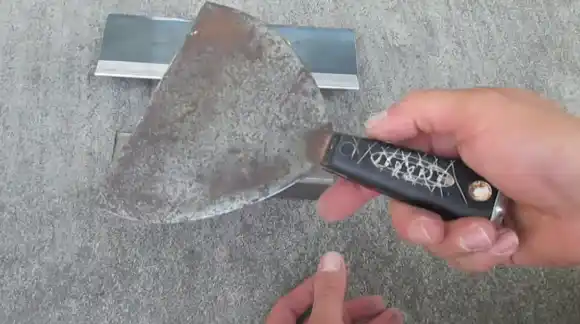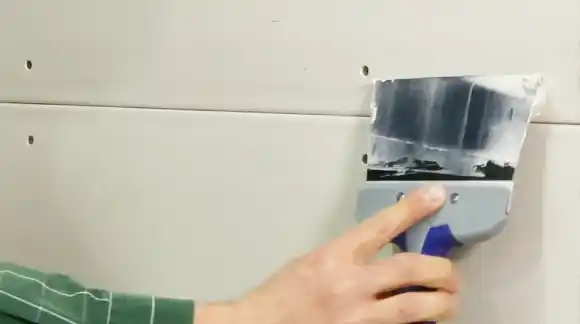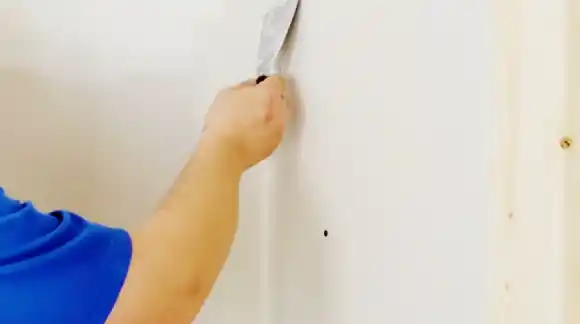Last Updated on February 5, 2023
A drywall knife is an essential tool for any do-it-yourselfer or professional drywall installer. While it may seem like a simple tool, a drywall knife can be the difference between a smooth, finished wall and a rough, uneven one. As an important part of achieving the best results, keeping your drywall knife sharp is crucial.
A dull knife will not only make it difficult to cut through the drywall, but it can also leave unsightly gouges behind. Blunt knives can also cause several problems, such as splitting drywall paper, tearing chunks out of the sheet, and not providing accurate tape work.
You may not know how to sharpen a drywall knife properly, and if you’re not careful, you can easily damage the blade. We’re here to help. In this post, we’ll show you how to sharpen your drywall knife like a pro using a simple 3 steps process.
How to Sharpen a Drywall Knife: Step-By-Step Instruction

Like any tool, a drywall knife will eventually become dull with use. When this happens, it’s important to know how to sharpen the blade so that it can continue to perform at its best. The good news is that sharpening a drywall knife is a relatively simple process requiring only a few supplies.
Here’s what you’ll need:
- A sharpening stone
- Water
- A clean cloth
- A pair of gloves
Once you have all of the necessary supplies, it’s time to get started. Let’s take a look at the step-by-step instructions to get your drywall knife as sharp as possible.
Step 1: Prepare the Drywall Knife
The first step is to make sure the blade of your drywall knife is clean and free of any debris. Because drywall knives tend to become very dirty over time. Plus, if there is any grit or dirt on the blade, it can create an uneven surface that will make sharpening more difficult.
Sometimes a simple wipe-down with a clean cloth is all you need. If necessary, you can also use a damp cloth and some mild soap to wash off any residue. It may be helpful to soak the blade in a solution of water and mild soap for a few minutes before wiping it clean.
Step 2: Sharpen the Drywall Knife
Now that you’ve cleaned the drywall knife, it’s time to sharpen the blade. Start by wetting the sharpening stone with water. This will help create a slurry between the stone and the blade for faster sharpening.
Once the stone is wet, place it on a flat surface and hold your drywall knife at an angle against the stone. Push down firmly as you draw the blade across the wet stone. You’ll want to be sure to keep consistent pressure throughout the entire process.
You can sharpen the blade with a concrete sidewalk or a concrete block if you don’t have a stone. Just be sure to only use the flat side of the sidewalk or block, as using the edges can damage your knife.
Keep in mind that you’ll need to sharpen both sides of the knife, so you’ll have to flip it over and repeat the process on the other side. You should sharpen each side at least 10-15 times to ensure that the blade is sharpened adequately.
Step 3: Clean and Store the Drywall Knife

Upon completion of sharpening the drywall knife, it’s essential to clean it off to remove any residue from the stone or sidewalk. The best way to do this is to rinse it under running water. Also, be sure to wipe it down with a clean cloth.
When the knife has been cleaned, it should be stored in a safe place where it won’t be damaged. A good option is to wrap it in a rag and put it in a drawer or toolbox. This will keep the knife from becoming dull and prevent any accidents from occurring.
How to Maintain a Sharp Drywall Knife?
Once you’ve sharpened your drywall knife, it’s essential to take care of it so that it stays sharp. Here are a few tips for maintaining sharpness:
- Store the knife safely, out of reach of children or pets.
- Clean the blade with a cloth after each use to remove debris and rust.
- Oil the blade regularly to prevent rusting and corrosion.
- Avoid using the blade for tasks other than drywall work.
- Always make sure the blade is dry before or after use.
- Do not store the blade in its sheath for long periods, as this can cause rusting.
- Inspect the blade for any signs of wear or damage before use.
Your drywall knife will remain sharp and in good condition for many years to come if you follow these tips. With proper maintenance, you can enjoy outstanding results with every job. Also, always try to use the best quality drywall knife to obtain the best results.
Here are some recommendations for drywall knives that you can buy.
Stainless Steel Drywall Mud Knife
When it comes to drywall mud knives, this drywall mud knife set provides the best performance. The drywall taping knives in this set provide superior durability and strength. Plus, they won’t corrode or rust over time.
Spackle mud Knife for Drywall Finishing

This Knife for drywall finishing sets provides precise control due to its long, flat design. Its lightweight construction and flexible taping knife blade make this knife ideal for smoothing and leveling joint compound or spackle.
Drywall Spackle Knife for Smooth Finishing
For smooth finishing on drywall, this is a reliable and dependable tool for quickly and efficiently completing jobs. The sharp, angled blade allows for an efficient and clean cut. Plus, it’s made of sturdy stainless steel that won’t rust or corrode over time.
Does Direction Matter When Sharpening a Drywall Knife?
It is true that direction matters when sharpening drywall knives. To get the best edge on your drywall joint knife, it’s important to keep the blade at an angle of 40-45 degrees while you’re sharpening.
Most people don’t think about the direction they’re sharpening their knife in, but it actually makes a big difference. If you’re sharpening your knife at too shallow of an angle, a sharp edge won’t be possible.
Alternatively, if you sharpen at too high of an angle, you run the risk of damaging the edge of your blade. Angles between 40 and 45 degrees are considered to be the sweet spot. This may take a little practice to get right, but it’s worth it for a sharp, durable edge.
What Happens If You Sharpen a Drywall Knife At the Wrong Angle?
Whenever sharpening a drywall knife, it’s important to use the right angle. Several things can happen if you don’t sharpen your knife at the right angle.
Here are a few of the most common issues that can arise:
- You won’t be able to remove enough metal to create a sharp edge.
- The edge won’t be sharp enough, so it won’t cut as quickly or accurately.
- The blade will become weaker and more prone to breaking.
- Instead of sharpening your knife, you may dull it.
- Your blade will end up rounded, making it tricky to sharpen in the future.
- There’s a chance that you could damage the blade by removing too much metal.
As you can see, it’s important to make sure that you’re getting the angle right every time you sharpen a drywall knife. Doing so will ensure that your blade stays sharp and durable for many years to come.
Should Drywall Knives Be Sharpened Wet or Dry?
It is generally recommended that for drywall knives, it is preferable to sharpen them wet instead of dry. Using a wet stone or other wet surface is much easier and more effective than sharpening your drywall knife over water-soaked surfaces.
This is because water provides a lubricating film that prevents the drywall utility knife blades from overheating, and it also helps to flush away any metal filings that could damage the blade. Also, the weight of the water or oil can help to keep the stone in place while you are working.
Still, there are some situations where dry-sharpening may be the better option. For instance, if you are working with a very dull blade, dry-sharpening may help to remove more material more quickly.
Ultimately, the best method will vary depending on the situation, but wet sharpening is generally regarded as the safest and most effective option.

Is Sandpaper Useful For Sharpening Drywall Knives?
Most people think sandpaper is useful only for smoothing down rough edges on wood. It is also possible to sharpen a dull drywall knife with sandpaper. To sharpen a knife with sandpaper, start by covering a brick or block of wood with the sandpaper.
Then, run the drywall knife across the sandpaper in a circular motion, paying attention to both sides of the blade. The abrasive action of the sandpaper will remove any burrs or chips from the blade, and it will also help to realign the edge.
After a few passes with the sandpaper, your knife should be noticeably sharper. Wet stones and other sharpening tools are more effective than sandpaper. Also, the paper may become embedded in the blade over time, so it’s best to use this method only when necessary.
You Might Like: How do Mac Tools and Snap Ons differ from other tools?
Does WD40 Work Well for Sharpening Drywall Knives?
WD-40 is a petroleum-based solvent and lubricant that many people use for all sorts of household tasks, from getting rid of water stains to lubricating door hinges. Unfortunately, WD-40 is not an effective tool for sharpening drywall knives. Metal filings and swarf cannot be effectively removed by the solution due to their rapid evaporation.
As a result, knives that are sharpened with WD-40 are more likely to be dull and ineffective. There are a number of other more effective sharpening methods, such as honing with a honing stone or using a power sharpener. So, next time you need to sharpen your drywall utility knife, reach for one of these other options instead of WD-40.
Sharpening a Drywall Knife: Is It Necessary?
If you’re new to drywalling, you might be wondering if it’s necessary to sharpen your drywall knife. Actually, the knife doesn’t need to be very sharp, a good edge is all that’s needed for the job. This will make the work easier and more accurate. When your drywall putty knife is dull, it can cause the drywall compound to bunch up, making it difficult to spread evenly.
A dull knife is also more likely to tear the paper on the drywall, leaving behind ugly streaks. For these reasons, it’s a good idea to keep your knife work sharp. So now you know everything you need to know about how to sharpen a drywall knife. Now get out there and enjoy creating beautiful walls.



